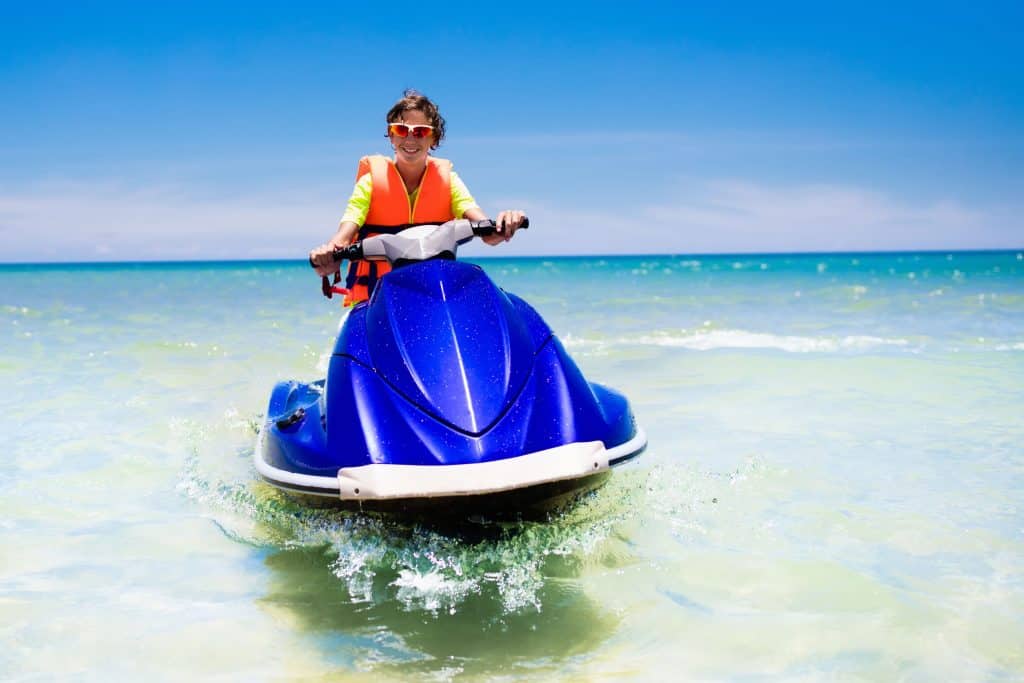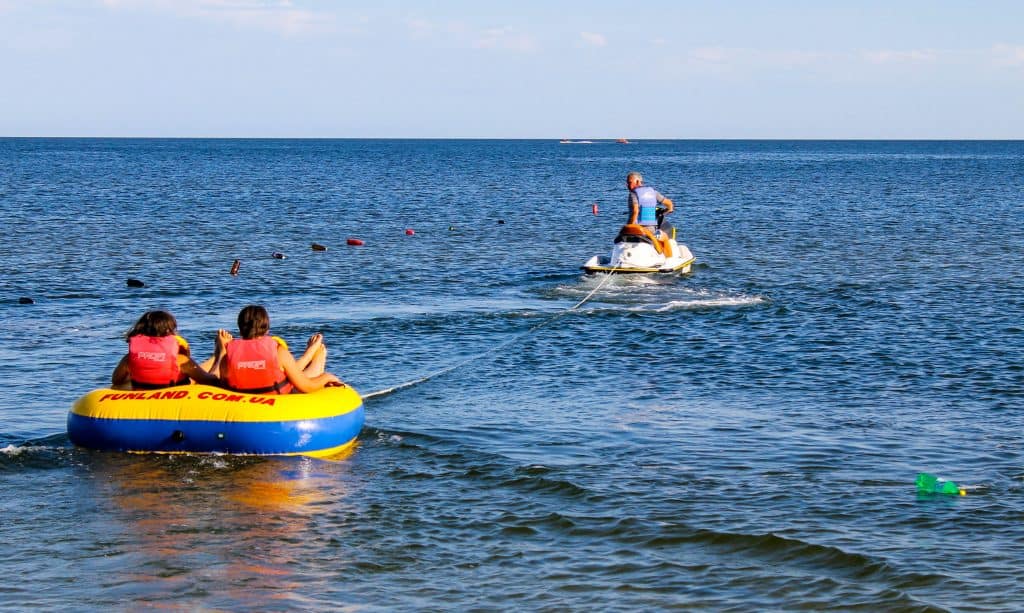Jet skiing in the summertime is a great way to make some cherished memories with family and friends. To make sure you do not come across any bumps with law enforcement while on the water you will need to know the rules and regulations for jet skiing in the state of Maine. These rules can vary from state to state but it is a need-to-know in order to enjoy your time.
If you are between the ages of 16 and 18 years old you can use a PWC or another water vessel if you completed the boating education course provided by the state (you will also need proof of age if you are operating on the certificate). If you have not completed the course you can just have someone 18 years of age or older accompany you on the PWC or vessel.
It is important to be aware of the following regulations and laws for riding a jet ski on the water within the state of Maine. By doing so you are responsibly following the law and that will guarantee you have an adventurous and stress-free time on your jet ski with family and friends.

Registering your PWC
Maine Registration Fees
Personal Watercraft Registration Fee: $45.00 (with the lake and river protection sticker)
Personal Watercraft Registration Fee: $35.00 (without the lake and river protection sticker)
Numbers and Stickers
Once you receive your registration number and the validation stickers you must display these items in the following ways:
- There cannot be any other numbers shown on the bow of your vessel.
- The letters have to be separated from the numbers with a hyphen or space.
- Each number has to be painted, applied onto your vessel as a decal or placed to be shown on both sides of the bow.
- The numbers must be read from left to right on both sides.
- Each number must be in block letters and three inches high.
- The color of your numbers must also be in contrast to the color of your vessel.
Hull Identification Number
A Hull Identification Number (HIN) is a 12-digit number that is assigned by the manufacturer to vessels built after the year 1972. HIN helps be able to determine the difference between multiple vessels.
In case your vessel is stolen you should write down your HIN and place it somewhere safe and secure.

The Basics
PWC Rules and Regulations
- you cannot operate a PWC within 500 feet of a designated swimming area
- reckless operation of a PWC is not allowed. Examples of this are:
- jumping a wake too close to another vessel
- last minute avoidance of a collision
- weaving carelessly through traffic
- carrying more passengers on your PWC than is recommended
- if you maneuver your PWC in such a way that it can cause unreasonable harm to you or your passengers
- it is illegal to operate a PWC between the hours of sunset and sunrise especially when your vision is a bit restricted during the late hours
- you cannot remove any backfire flame arrestor or ventilator if it is installed by your manufacturer
- you must have a whistle or horn on board your PWC that is U.S. Coast Guard approved
- the safety ignition switch must be fully functional and have a lanyard attached to it to ensure it does not get lost or misplaced
- each person on the PWC must wear a U.S. Coast Guard approved type 1,2, or 3 personal flotation device.
Reckless Operation of a Vessel
Failure to Regulate Your Speed
When you operate your vessel at a faster speed than recommended you are putting those around you and yourself at risk for getting hurt.
Especially during vessel traffic, poor weather conditions, and closeness to shore you will need to follow the speeding regulations posted by the state you reside in.
Examples of this are:
- Operating your vessel at extreme speeds in the close vicinity of another vessel, PWC, or dangerous waters.
- Going at a speed that can be harmful to your vessel.
- Operating at a greater speed than “slow, no wake” speed that is posted in a “no wake” zone.
- Going faster than the speed limit posted near the body of water you are operating on.
Improper Distance Between Others
If you are operating your vessel faster than 5 mph while operating within 100 feet of the shore, dock, pier, raft, float, or an anchored or moored vessel you are operating your vessel improperly and putting others around you at risk.
Riding on the Bow, Deck, or Gunwale of a Vessel
Riding on anything that is not equipped with fixed seating can lead to the potential of falling overboard. Do not allow your passengers or yourself to sit on the seat back, transom, gunwale or on seats on raised decks or a bow.
Reckless Operation Specifics
This is when your weave through traffic, swerve last minute to avoid a head-on collision with another vessel or overload your vessel beyond the capacity it states on the plate.
Unsafe Conditions
Not having enough personal flotation devices, fire extinguishers, backfire flame arrestors, ventilation systems, or navigational lights are putting yourself and others abroad your vessel at risk.
You also put yourself and others in danger when you overload or overpower your boat or when you are operating the vehicle while intoxicated.
Alcohol and Drugs
In the state of Maine you cannot operate a PWC or any other water vessel if you do any of the following:
- Be under the influence of alcohol or drugs or even a combination of alcohol and drugs
- Have a 0.08% blood alcohol content if you are 21 years old or older
- Having any amount or trace of alcohol in your blood if you are under 21 years old
If you are found guilty of boating under the influence then you can be subjected to imprisonment.

Required Equipment
Personal Flotation Devices
| Type 1 | Offshore Life Jackets | This vest can turn an unconscious person in the water to face up in the water. It was made for rough waters and for situations where rescue might take a long time. |
| Type 2 | Near-Shore Vests | This vest is fit for calmer waters and faster rescues. If you were to wear this while unconscious it may not be able to turn your face up in the water. |
| Type 3 | Flotation Aids | This vest can also be a full-sleeved jacket and it is great for calm waters and fast rescues. This will definitely not turn your face up in rough waters. This is generally worn for water sports. |
| Type 4 | Throw able Devices | This type of flotation device is a cushion or ring buoys and are typically used to throw at someone in trouble. They are not made to last for long hours in the waters, or non-swimmers, or the unconscious. |
| Type 5 | Special-Use Devices | This type of flotation device was made for activities like kayaking, water-skiing These typically look like white water vests, deck suits, and personal flotation device hybrids. |
Requirements for PFDs
- a type 4 PFD, that is approved by the U.S. Coast Guard, must be on board a vessel that is 16 feet or longer and it must also be easily accessible for emergency use
- vessels have to have 1 of the 5 PFDs on board and they also must be a wearable size for any passenger or operator
- any person that is on board a PWC or vessel (no matter the age) must wear a PFD
Fire Extinguishers
You can classify your fire extinguishers by letter and number symbol. The number is there to help you decipher the size of your extinguisher, and the letter is there to help you indicate the type of fire that extinguisher can put out.
| TYPE A FIRES | These types of fires are combustible solids such as wood |
| TYPE B FIRES | These types of fires are flammable liquids like gasoline or oil |
| TYPE C FIRES | This type of fire is mainly electrical fires |
These fire extinguishers must stay in a usable condition. You need to regularly check up on the extinguishers to ensure they are in the best condition:
- Seals and tamper indicators are not broken or missing
- Pressure gauges or indicators read in the operable range
- There is no physical damage, corrosion, leakage or clogged nozzle.
If an Accident Occurs…
In the terrible event of an accident occurring while you or another person is using a vessel or PWC. The operator must submit a written casualty or accident report if…
- a person dies
- a person is unable to perform normal or usual activities
- there is damage to the vessel or other property damage and it totals to more than $2,000 or if there is a complete loss of the vessel
- a person disappears from the vessel and it may indicate possible death or injury
Law Enforcement
The Maine game wardens, Marine Patrol officers, local harbor masters, and any other form of law enforcement officers control federally controlled waters.
- They have the authority to stop your PWC or vessel in order to ensure that you are following the rules and regulations posted by the state.
- It is also illegal to refuse the commands of the law enforcement officers.
